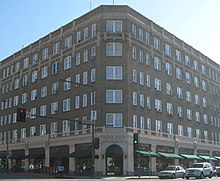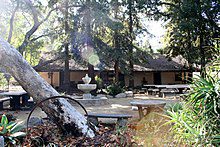Glendale
Glendale is a city in the Verdugo Mountains region of Los Angeles County, California. As of the 2010 census it had a population of 191,719, and in 2019 the population was estimated at 204,765, making it the fourth-largest city in Los Angeles County and the 23rd-largest city in California. It is located about 10 miles (16 km) north of downtown Los Angeles.
History
Glendale incorporated in 1906, and annexed Tropico 12 years later. An important civic booster of the era was Leslie Coombs Brand (1859–1925), who built an estate in 1904 called El Miradero, featuring an eye-catching mansion, the architecture of which combined characteristics of Spanish, Moorish, and Indian styles, copied from the East Indian Pavilion at the 1893 World’s Columbian Exposition held in Chicago, which he visited. Brand loved to fly, and built a private airstrip in 1919 and hosted “fly-in” parties, providing a direct link to the soon-to-be-built nearby Grand Central Airport. The grounds of El Miradero are now city-owned Brand Park and the mansion is the Brand Library, according to the terms of his will. Brand partnered with Henry E. Huntington to bring the Pacific Electric Railway, or the “Red Cars”, to the area. Today, he is memorialized by one of the city’s main thoroughfares, Brand Boulevard.
The city’s population rose from 13,756 in 1920 to 62,736 in 1930. The Forest Lawn Cemetery opened in 1906 and was renamed Forest Lawn Memorial-Park in 1917. Pioneering endocrinologist and entrepreneur Henry R. Harrower opened his clinic in Glendale in 1920, which for many years was the largest business in the city. The American Green Cross, an early conservation and tree preservation society, was formed in 1926 (it disbanded three years later and the current organization of that name is unrelated).
Geology
Several known earthquake faults criss-cross the Glendale area and adjacent mountains, as in much of Southern California. Among the more recognized faults are the Sierra Madre and Hollywood faults, situated in the city’s northern and southwestern portions, respectively. Additionally, the Verdugo and Raymond faults intersect through the city’s central and southeastern areas. The San Gabriel fault, meanwhile, is located northeast of the city. Roughly 75 miles northeast of Glendale is a major portion of the San Andreas Fault known as the “Big Bend”, where quake-recurrence tracking shows major activity roughly every 140–160 years. The closest portion of the San Andreas is actually 29 miles from Glendale. The last major quake along the southern San Andreas was recorded in 1857.Forest Lawn Memorial Park and the Verdugo Mountains.
In the 1971 San Fernando earthquake, which took place along the western edge of the Sierra Madre Fault, surface ruptures were nearly 12 miles (19 km) long, including one portion a few miles northwest of Glendale. Most of the damage was in the northern San Fernando Valley, though 31 structures in Glendale suffered major damage and had to be demolished, plus numerous chimneys collapsed. The 1994 Northridge earthquake had an epicenter about 18 miles (29 km) from Glendale. The city suffered severe damage to a public parking structure and sections of the Glendale Galleria parking structures and exterior columns incurred damages.
Geography
Glendale is located in the southeastern San Fernando Valley. The city has a total area of 30.6 sq mi; 30.5 square miles of it is land and 0.13 square miles of it (0.43%) is covered by water. It is bordered to the north by the foothill communities of La Cañada Flintridge, La Crescenta, and Tujunga; to the south by the Atwater Village and Glassell Park communities incorporated by the city of Los Angeles; to the east by Pasadena and Eagle Rock (also incorporated within Los Angeles); and to the west by Griffith Park and the city of Burbank. Glendale is located 10 miles (16 km) north of downtown Los Angeles.



